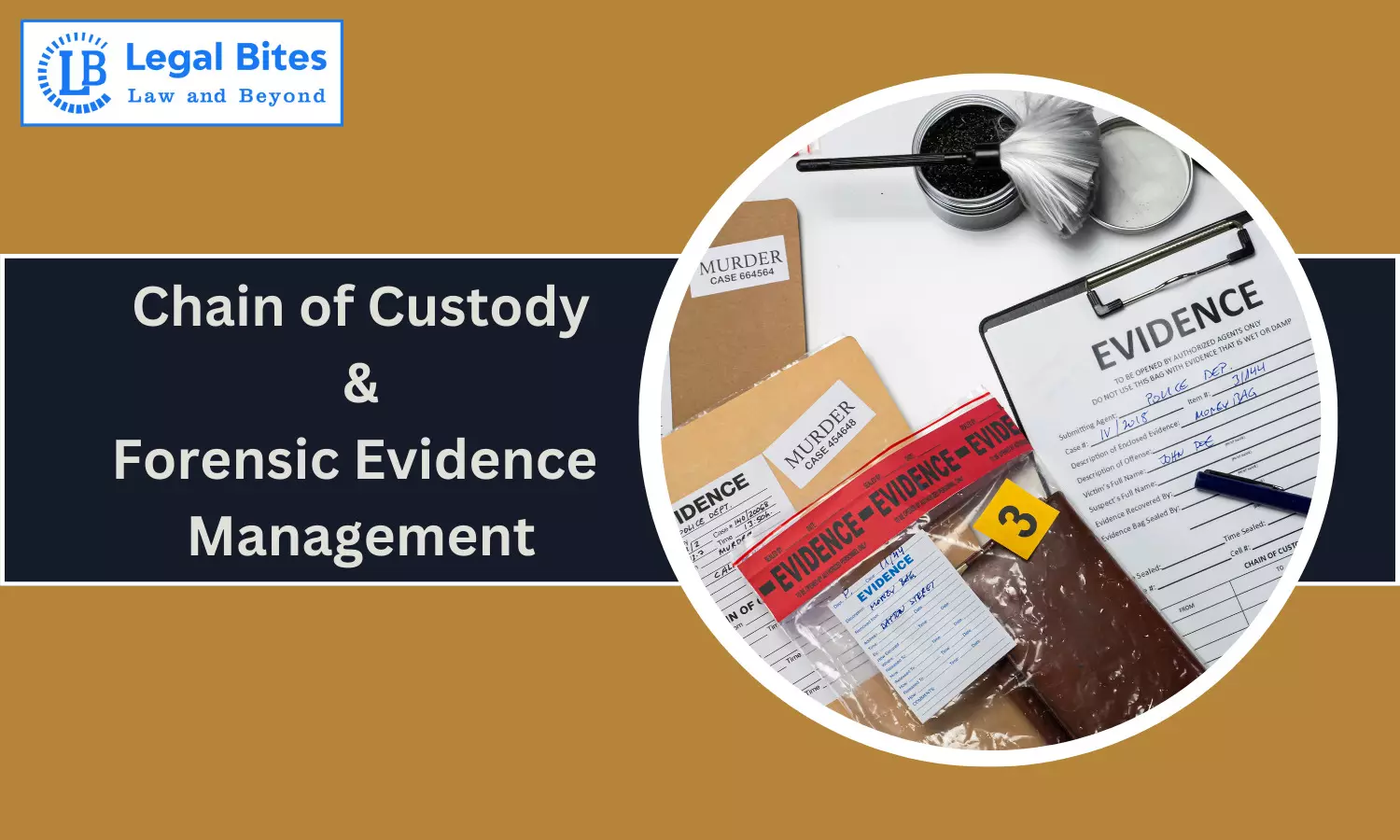Chain of Custody and Forensic Evidence Management
The article 'Chain of Custody and Forensic Evidence Management' explores the significance of a meticulously documented chain of custody in preserving the integrity and admissibility of evidence in legal proceedings.

The article 'Chain of Custody and Forensic Evidence Management' explores the significance of a meticulously documented chain of custody in preserving the integrity and admissibility of evidence in legal proceedings.
Chain of Custody: Introduction
Chain of custody refers to the whole process involving the evidence in a legal case. The sequential process which thereby includes the acquisition/ custody, control and subsequent transfer of the evidence is referred to as the chain of custody. It is imperative to note that this is a very crucial aspect of evidence recording and examination. Meaning to say, if there is any compromise in any of the steps involved in the chain of custody, the same would lead to a breach of authenticity of the said evidence and thus its validity would come into question in the court of law.
Preservation of the chain of custody thus comprises two major aspects: first is adhering to the correct procedure for protection and maintenance of the chain of custody and second is to make sure that the quality of the said evidence is maintained as it originally was. Evidence documentation thus entails the process of critically maintaining the chain of custody. In order to make the evidence reliable in a court of law and to establish its unquestionable authenticity, it is important to maintain honesty and accuracy in the chain of custody of the said evidence.
Importance of ‘Chain of Custody’
In order to make the evidence reliable and to establish its integrity, it is important to maintain a chain of custody. Moreover, an imperative part of maintaining a chain of custody is the maintenance of a paper trail that enlists all the people’s names who have thereby handled the said evidence or helped in transferring it from one place to another. This is very crucial as it assists in ascertaining the names of the persons responsible for the said evidence and they can also be summoned for testifying in the court of law in case there is any need for the same due to questions on the evidence’s authenticity etc.
i) Avoiding evidence tampering - Maintenance of chain of custody with integrity is also important for avoiding any type of tampering with it. If there is any tampering, the evidence can be said to have been compromised and the court of law shall not accept it in order to ascertain any legal conclusion. There is a need for the evidence to be preserved in honest hands so that the same can be used for proving the guilt or innocence of the said accused.
ii) Presenting Chain of Evidence Custody in Court - In order to make the said evidence admissible in the court of law, it is important to submit, along with the submission/ presentation of the very evidence as an exhibit, the list of chain of custody. This chain of custody must contain in detail each and every transmission of the evidence, which shall begin from the moment when the evidence is collected and shall continue till the same is presented in the court of law. This helps in proving that there was no tampering with the evidence as there was no possible way that any unauthorised person could have gotten access to the said evidence.
iii) Maintenance of chain of custody important in Forensic Practice - This is of utmost importance as every examination and analysis of the evidence must be recorded adequately. This is a liability on every person who comes in contact with the said evidence and is a part of the said examination. This documentation must also contain the processes applied for examination in order to postulate the accuracy of the results being presented in the court of law in relation to the said evidence.
iv) Prevention of ‘Access to Evidence - As the same has also been discussed above, chain of custody permits only those persons to come in contact with the said evidence who are supposed to, and who shall help in finding its veracity in context to the guilt/ innocence of the accused. Police officers and unauthorised lab officials shall thus be excluded from being a part of a chain of custody if not permitted and they shall not be allowed to touch or tamper the evidence.
Generic Process for Maintaining Chain of Custody
Here it is first relevant to note the three main purposes for which chain of custody is maintained:
i) Asking relevant questions relating to the evidence in the analytical laboratory
ii) Maintenance of record of the chain of custody
iii) Assure and prove that the evidence was handled by personnel that is thereby approved to handle it and thus, no tampering occurred
Now, starting with the process of maintaining the chain of custody; the person responsible for the same is required to put labels on the said evidence for proper identification purposes. Along with proper labelling, the sample container bags must be used to contain the evidence. There is a unique identification code that is given to each sample bag containing the evidence.
There is also a record register maintained containing this identification code, the location where it was extracted from, the name of the person who submitted it, his signature and the time of submission. It is also important to pack the evidence properly in order to prevent any damage during the transit.
Generally, the following should be maintained in the chain of custody:
- Unique identifier
- Name and signature of the sample collector
- Official address and contact number
- Name of the recipient
- Laboratory's address
- Details of each sample, including:
- Unique identifier and matrix
- Date and time of collection
- Type of analysis required
- Signatures of everyone involved in the chain of possession with date and time
- Date and method of delivery
- Authorization for the analysis of the sample
- Any other information about the sample
The chain of custody process can be understood as comprising of the following four steps:
a. Data Collection
b. Examination of the collected data
c. Analysis of the collected data
d. Reporting the result of the examination and analysis
Let us briefly discuss the 4 steps of the chain of custody as mentioned above:
Data Collection - The initial stage of the chain of custody process comprises the collection of data. Roughly the following form part of this process- identification, labelling as required, and recording of the data that is thus acquired from various sources.
Examination - The forensic process that is undertaken is highlighted in this stage. Capturing screenshots is highly important in this stage in order to record the tasks completed and the evidence thereby recorded.
Analysis - The result of the examination is further decoded in the analysis stage. Methods that are legally justifiable are put to use during this stage—the purpose is to address the questions that are part of the case.
Reporting - The documentation stage of the chain of custody is known as reporting. The report that is produced must contain the following: a statement regarding the chain of custody, mentioning of tools and methods used for examination, issues/ vulnerabilities that are identified henceforth, and recommending additional forensic measures.
Conclusion
Professional and ethical standards must be adhered to while maintaining of chain of custody. Relevant awareness must be made for implementing correct procedures for an accurate chain of custody in order to avoid any tampering of evidence which would vitiate its veracity in a court of law. Thus, it can be understood that with regard to collecting and presenting forensic evidence, chain of custody remains the most critical and crucial aspect.
References
[1] Ashish Badiye, Neeti Kapoor & Ritesh G. Menezes, Chain of Custody, Available Here
[2] Chain of Custody – Digital Forensics, Available Here
[3] Priyal Jain, Chain of Custody, Available Here
[4] Archana Singh, Chain of Custody, Available Here

